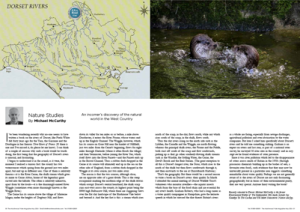An incomer’s discovery of the natural world in the West Country

I’ve been wondering recently why no-one seems to have written a book on the rivers of Dorset, like Freda White did forty years ago for the Tarn, the Garonne and the Dordogne in her famous Three Rivers of France. (If there is one and I’ve missed it, do please let me know). I can think of a couple of reasons why such a book would be worth doing, the first being that the geography of Dorset’s rivers is unusual, and fascinating.
I began to understand it in the round, as it were, the moment I realised a curious fact: the county has two watercourses which spring from the ground just two miles apart, but end up in different seas. One of them is relatively famous—it is the River Cerne, the chalk stream which gives its name to Cerne Abbas, home of the legendary giant carved into the hillside. The other is relatively unknown, apart from by the locals—it is the charmingly-named River Wriggle (sometimes even more charmingly known as the Wriggle River.)
The Cerne has its source above the village of Minterne Magna, under the heights of Dogbury Hill, and flows down its valley for ten miles or so before, a mile above Dorchester, it enters the River Frome, whose waters end up in the English Channel. The Wriggle, however, which has its source on Gore Hill near the hamlet of Hillfield, just two miles from the Cerne’s beginning, flows for eight miles through Chetnole (where it often floods the village) and then Yetminster, before joining the River Yeo, which itself flows into the River Parrett—and the Parrett ends up in the Bristol Channel. Thus a rubber duck dropped in the Cerne at its source will ultimately end up in the sea on the other side of England, from a rubber duck dropped in the Wriggle at its own source, just two miles away.
The reason is that the two sources, although close, are on opposite sides of a great divide. This is the steep escarpment marking the northern edge of the chalk downs which occupy Dorset’s central heartland; the chalk scarp runs east-west across the county, its highest point being the 899ft high Bulbarrow Hill, where there are staggering views over the flat clay landscape of the Blackmore Vale below and beyond it. And the key fact is this: a stream which rises north of the scarp, in the clay, flows north, while any which rises south of the scarp, in the chalk, flows south.
Thus the clay rivers rising on the north side such as the Lydden, the Caundle and the Wriggle, are north-flowing; whereas the principal chalk rivers, the Frome and the Piddle, both start off south of the scarp and flow southwards, picking up as they go other southerly-flowing chalk streams such as the Wrackle, the Sydling Water, the Cerne, the Devil’s Brook and the Bere Stream. (The great exception to all this is Dorset’s longest river, the Stour, which rises to the north of the chalk but then flows southwards through it, and then eastwards to the sea at Christchurch Harbour.)
That’s the geography. But there would be a second reason to write a book on Dorset’s rivers: their quality. In March I attended the annual meeting of Dorset Wildlife Trust’s volunteers who monitor riverflies—the aquatic insects which form the base of the food chain and are essential for any river’s health. Graham Roberts, who had a long career as a water quality campaigner in Hampshire, gave the keynote speech in which he stressed the dire threats Britain’s rivers as a whole are facing, especially from sewage discharges, agricultural pollution and over-abstraction by the water companies. But later I asked him specifically about Dorset’s rivers and he told me something striking. Graham is an expert on otters and last year, as part of a national otter survey, he surveyed 50 river sites in the county: and in every single one he found evidence of otter presence.
Since it was river pollution which led to the disappearance of otters across much of Britain in the 1950s (through poisonous chemicals building up in the bodies of eels, a favourite otter food), such evidence that they may now be universally present in a particular area suggests something remarkable about water quality. Perhaps we are not generally aware of it: the rivers of Dorset are not only fascinating geographically, but in terms of their environmental purity, they are very special. Anyone fancy writing the book?



